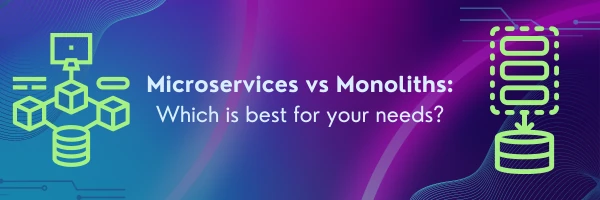Microservices and Monoliths are both effective software development architectures, but like any technology, their effectiveness depends on your specific needs. These two models are opposites of one another, so it’s important to understand the key differences and decide which is best for your business. Let’s explore what these models are.
What are Monoliths and Microservices?
Image credit: itoutposts.com
Monolith is the traditional software development architecture that uses a single codebase to perform various business functions. These are a good option for a small business with limited resources and a simple business plan.
Pros:
- Simple Deployment: Since monoliths use a single codebase, they require less planning up-front, then code modules can be added later on as needed.
- Requires fewer resources: With a single database, less developers are needed to manage the server.
- Simple Debugging: With one codebase to manage, bugs are easier to discover.
Cons:
- Less scalability: Monoliths are tightly coupled, so changing one single function would require the entire application to change. This becomes more time consuming and complicated to scale.
- Dependency: Each function of a monolithic application is dependent on another, making it less agile than microservices.
Microservices are a software development model that uses multiple small, independently deployable services that are focused on specific business logic and communicate over Application Programming Interfaces (APIs). This architecture is great for business with complex needs and plenty of resources.
Pros:
- Easily scalable: Microservices use cloud and container services to make them easier to scale.
- Agile: Small teams deploy changes frequently, allowing continuous improvement without having to redeploy an entire application at once.
- Reliable: Since changes can be deployed for individual services, it’s more reliable than having a monolithic application where a change would cause redeployment of the entire system.
- Specialization: Each microservice is designed to serve a specific function.
Cons:
- Complex: Since there are multiple microservices within a single application, it can pose a challenge to maintain all of the moving parts.
- Up-front planning: Though the use of microservices is more efficient over time, it does require thorough planning of each microservice needed and how they will communicate with one another through APIs.
- Debugging: A single team of developers may be responsible for multiple microservices, so debugging may require thorough testing and communication to fix the problem. This takes more time and resources.
- High Infrastructure costs: Cloud-hosting may cost more to manage an application.
- Increased Overhead: Requires effective communication and organization across all teams overseeing the microservices.
- Lack of standardization: The use of various technologies makes it difficult to standardize the application process.
Both monoliths and microservices can be excellent options for your organization. Since microservices are more popular, they may seem like the best choice. However, it may make more sense to stick to tradition - it really depends on your business’s needs and resources.
At Trinity IT, we use microservices for our own software development and modernize our customers’ legacy monolithic systems. This helps our customers be more flexible as future needs change. If your business could benefit from our expertise, please reach out to our business development lead, Emily Sims, at emily.sims@trinityit.biz.
,
